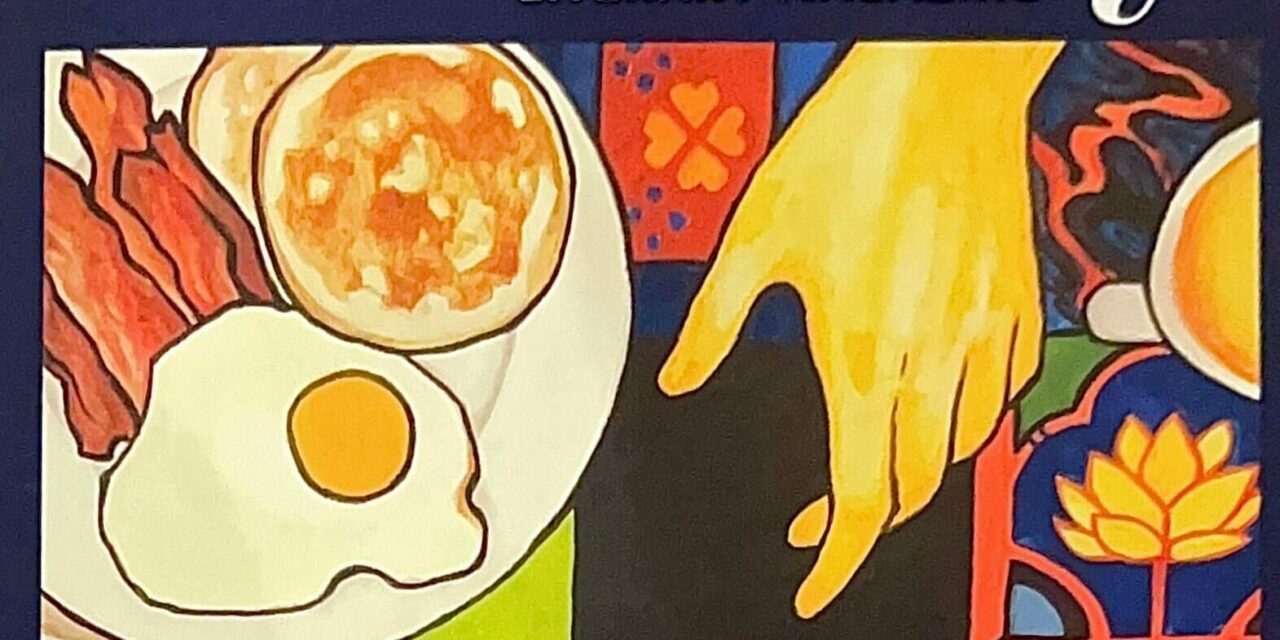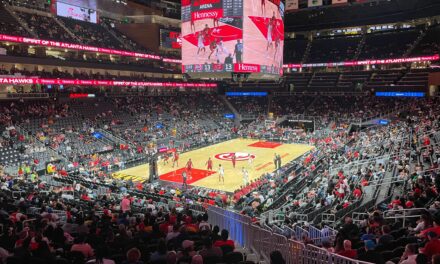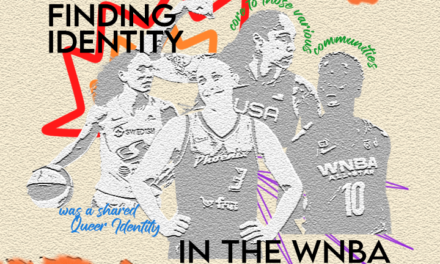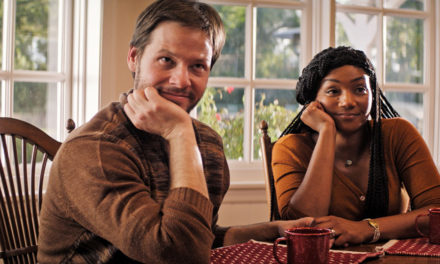On March 22, a Wonderful Wednesday, the Alloy Literary Magazine began to distribute their 2022-2023 edition. I scurried over to their stand to grab a copy.
School donors and alumni often read student-run literary publications like Alloy for a glimpse into the endeavors of current students. Literary magazines can often indicate an institution’s consistent pedagogical prestige. Prospective students may change their minds depending on what a given edition has to offer. Two big questions test the merit of a literary magazine: Is this publication of professional quality, and does it provide a comprehensive view of the student body?
From a glance, this year’s edition of Alloy certainly looks fancy. A conservative navy blue border frames the bright cover, the back listing the contributors in a polite serif font. The cover art showcases an overhead view of a breakfast, the table composed of tiles with lotus flowers, Seigaiha-mon waves and other nature scenes.
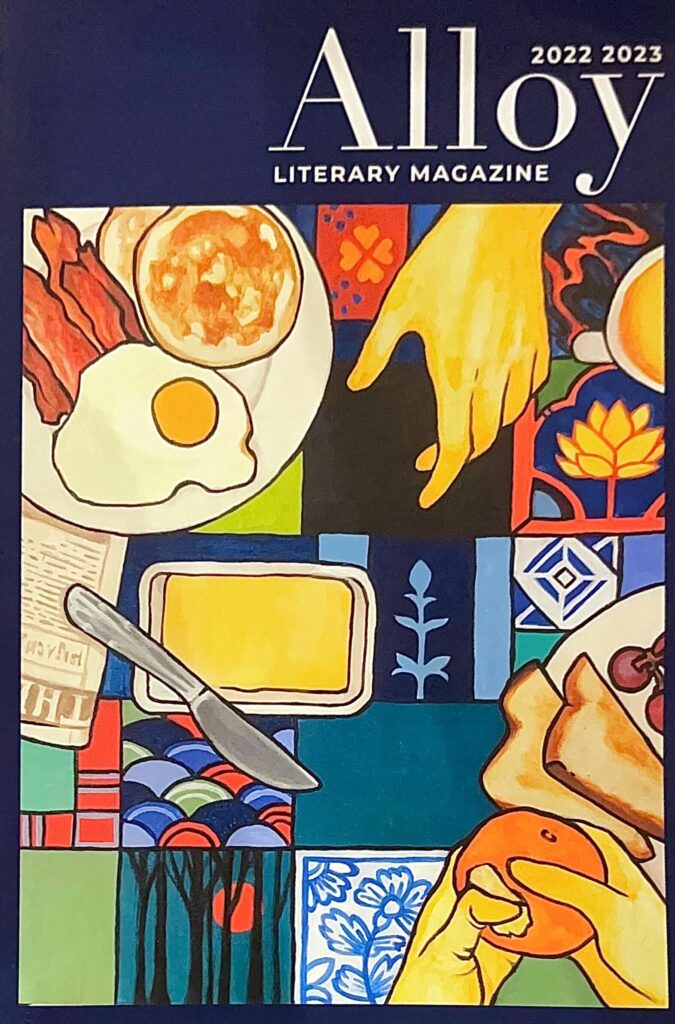
Courtesy of Alloy Literary Magazine
Alloy staff are listed on the opening page with a staff photo, a rare but appreciated sight that forms a more human connection between the readers and those behind the scenes. Editor-in-Chief Raegan Allen’s (23C) note to the readers is a professional and courteous introduction to the magazine. It is helpful to breathe life and personability into the guiding force of a publication.
I expected the magazine to include at least a few love poems, an unavoidable presence in a school publication, of which Alloy is no exception. In fact, the issue did begin with a love poem. The content of this sort of poetry could easily sound kitschy, and some of the poems were not immune to this. But for the most part, love and love-adjacent poems in this edition were more experimental than the cliche poems I had encountered in other publications, playing with delivery and imagery. I found this to be refreshing.
The writing submissions warmed my jaded artistic heart. I think any person could find a poem in this year’s edition that they like just from the breadth at their disposal; “Entry Points” by Macy Perrine (24C) and “Morning Sunlight” by Zuha Jaffar (25C) were some of a handful I particularly enjoyed.
I appreciated the contest-winning pieces. Alloy created prompts for each contest, which allotted more autonomy to the staff to control certain themes in this edition. With the prompts included, I got to see how the winners interpreted the material they were given in ways I never would have thought. It pleasantly surprised me that the cover art was a contest winner, too.
Alloy attracted some incredible photography as well. The subject matter is very diverse across the board: nature photography is sprinkled in among portraiture and candid scenes. In terms of other art, I expected there to be more drawings and paintings.
Precise page design and font sizing can save a few dollars in the long run by reducing page count per copy, but some publications require that every art piece is placed on its own page. In this issue, however, I noticed several instances when two separate pieces appeared on a single page, one visual art and the other literary. For contributors, this might feel like being spoken over, but for editors, it might be a necessary layout decision.
I encountered one glaring factor that impacted my entire impression of Alloy’s 2022-2023 edition: representation. The editor’s note reads, “Emory’s collective of creatives come from all its corners. … I encourage you to luxuriate in these offerings that not only characterize the artist themselves, but our greater campus community.” Sure, art submissions can and do come from all sorts of people and disciplines. But some quick math reveals that out of the 49 published submissions, 32 of them are staff pieces. The average number of final submissions for each showcased staff member came to about two pieces, four being the most for a single staff member and all the unaffiliated contributors. Perusing the Alloy staff bio pages at the end of the issue, I noted many of the contributors hail from similar disciplines in the humanities.
Bias is likely not the reason for this. It is common practice for publications to vote on submissions anonymously. According to Alloy, the magazine receives around 100 to 150 submissions between the beginning of the fall semester and the end of January. At a typical meeting Alloy considers anywhere from five to 10 submissions.
It makes sense that editors and staff like to share their work. They are creative-minded participants in a publication that serves their own artistic community on a predominantly preprofessional campus. However, that community can be a double-edged sword. My perspective into Emory’s art community as a freshman has shown me that it is highly elusive, if not exclusive. Among other hurdles, literary and compositional terminology is thrown around like hotcakes — and you have to be “in the know” to catch it. You need to have a workshop class or two under your belt. Publications have the platform to sway that impression depending on how receptive they appear to general art. While Alloy’s published copy may be unbiased, it does not seem that way.
So, how can literary publications like Alloy represent the “greater community,” not an art workshop?
Well, advertisement reigns supreme. Yes, Alloy appears at Wonderful Wednesday, but it took me multiple laps to find them on their most important day. Besides that, the only ways I learned about Alloy as a publication were club fairs, a stray Callaway Memorial Center flier and word of mouth.
Advertisement has to be as widespread as possible, on and in every single building or surface on campus for it to work. If it is not directly in someone’s face as they open a building door, you could say it was never even there. For a community to grow, it has to have a strong, consistent presence.
While Alloy has a solid reputation with quality submissions to boot, there is still room for improvement in more nuanced ways that some publications do not have the force to approach. I firmly believe Alloy is up to the task with what I have seen in this year’s edition. With some extra effort, I am sure Alloy will invite more of the diverse submissions it vowed to deliver.

